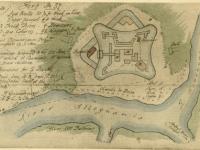In this lesson, students study maps and diagrams of Fort Pitt, with primary documents created by 18th century trader and militia captain William Trent, to construct a sense of how forts functioned during the French and Indian War, the experience of war at the fort, and the interactions of various peoples who lived, worked, and battled at the fort.
Life at Fort Pitt
Life at Fort Pitt
Essential Questions
Objectives
- Students will work in cooperative groups.
- Students will interpret and make inferences from a variety of primary source material.
- Students will construct an organized diagram.
- Students will evaluate primary resources and articulate the sources’ biases.
Primary Sources
Other Materials
Suggested Instructional Procedures
1. Before introducing the materials to your students, study the diagrams/maps of Forts Duquesne and Pitt for a couple minutes. Why do you think they were drawn? What is your initial impression about the diagrams/maps? What can you assume about the people that lived at the forts? What is the basis for your assumptions?
2. List the objects, natural features, key terms, and other important data from the diagrams/maps. Based on what you’ve listed, what might you infer about life at the forts?
3. What do you want to know about the forts or the people who lived at them that you don’t see in the diagrams/maps? Where might you find the answers?
4. Form cooperative teams. Give each team a copy of the graphic organizer on Pennsylvania forts. Using the maps and sketches of forts, have each group complete the graphic organizer based on information from the maps and sketches. Ask students to consider what additional information they would like to write a fuller description of life at Forts Duquesne and Pitt and how or where they might find the information.
5. Remind students that the maps and sketches are primary documents. Another type of primary document is a military orderly book, which records the general and regimental orders for each day. A diary or journal is also a primary document.
6. Divide the excerpts from William Trent’s orderly book and journal between the cooperative teams. Ask students to read the excerpts to add information to their description of life at Fort Pitt. Use the Comparing Primary Sources Worksheet to track which information is from the maps and sketches and which information is from the orderly book or journal.
7. Have each cooperative team share its findings with the class and create a class composite description of life at the fort. Encourage students to discuss how they determined what information to include on the graphic organizer. Then, as a class, read Trent’s biographical information. Discuss what about Trent’s life might have influenced his perspective. Remind students that all written accounts have a point of view or bias. Questions to consider are:
- What perspectives are missing?
- What are the benefits and limitations of using a written account as a primary document?
- What are the benefits and limitations of using a map or sketch?
- How might a person’s perspective influence what is included in a map or sketch?
Vocabulary
Centinal: a watchman in an army or militia
Delaware: the collective name used for the Munsee and Lenape Indians.
Empire: political unit owning extensive territory or nations and ruled by one authority, often a monarch or king.
Fort Necessity: British fort hastily erected and defended by George Washington that was captured by the French in 1754.
Fort Duquesne: a French fort built in 1754 at the meeting point of the Alleghany and Monongahela rivers, but was destroyed in 1758
Fort Pitt: a British fort built in 1759 next to the site of the former Fort Duquesne. Its location next to the river made it an important stronghold for the British during the war
Iroquois: powerful confederacy of Indian tribes that once occupied the area of New York State.
Land Speculator: A person who buys a great deal of land, waits for its value to rise, and then sells it for a profit.
Lenape: name for the group of Algonquin-speaking Indians that once lived in the lower Delaware Valley.
Militia: civilians trained as soldiers but not part of a regular army.
Native American: indigenous or original inhabitants of the Americas prior to European arrival.
Ohio Valley: name used in the 18th century for the region west of the Appalachian Mountains centered on the Ohio River. Control of this area was a main cause of the French and Indian War.
Settler: person who makes his or her home in a new region.
Treaty: binding agreement under international law.
Walking Purchase: name given to an agreement made in 1737 between the Penn family and the Delawares that resulted in the Indians feeling cheated out of land.
Related Resources for Students

Plans in this Unit
Grade Level
Duration
Standards/Eligible Content
About the Author
This lesson was created by Donna Sharer. Updated for SAS by Amy Seeberger, Education Intern, Historical Society of Pennsylvania.
Attention Teachers!
Let us know how you used this plan and be featured on our site! Submit your story here.

